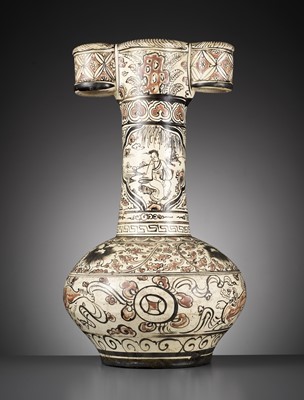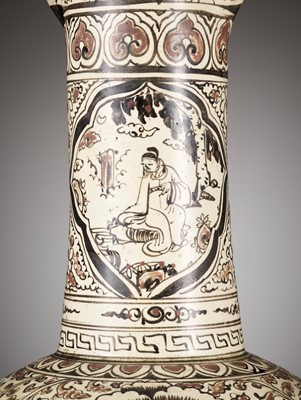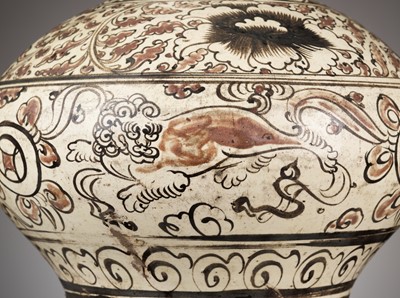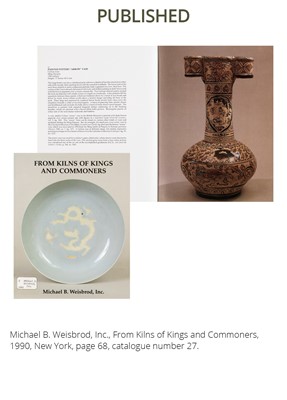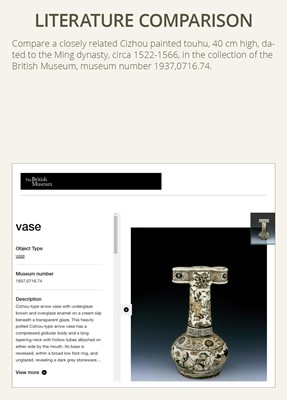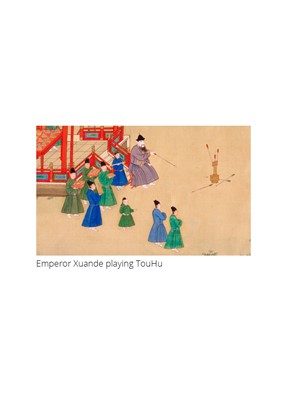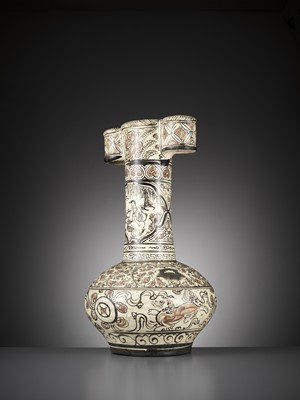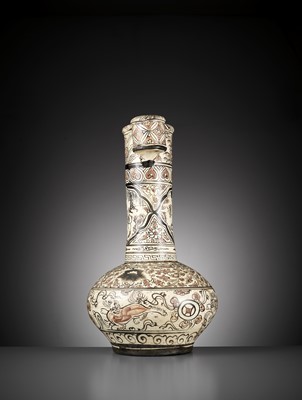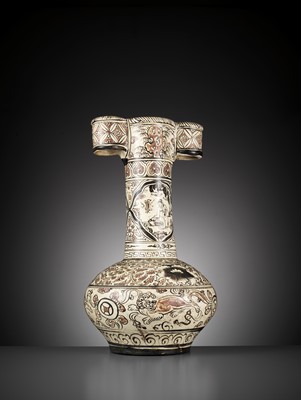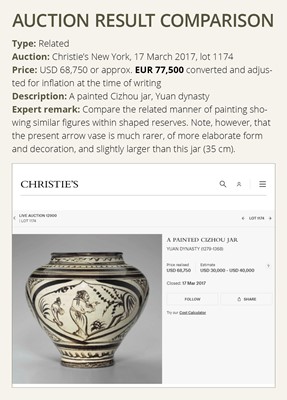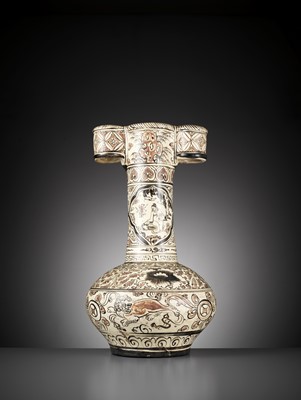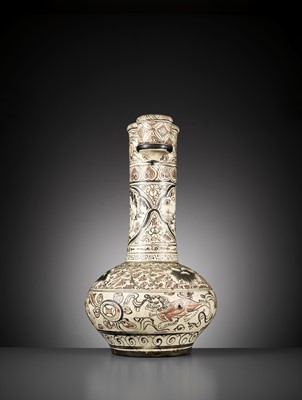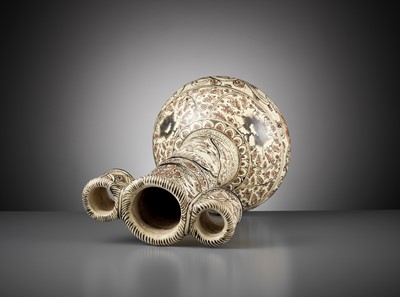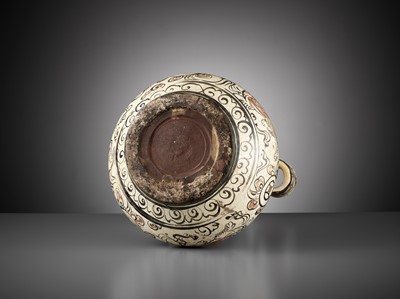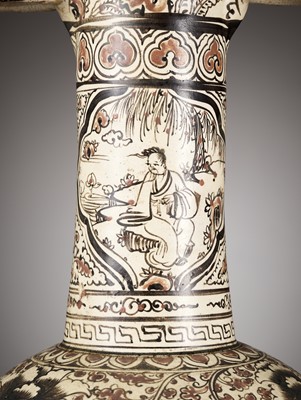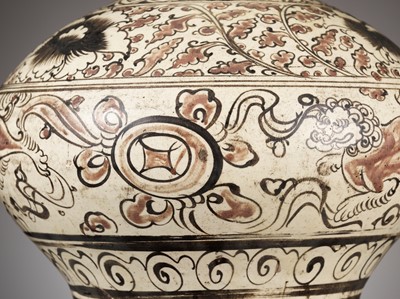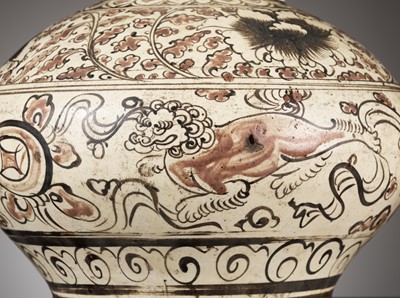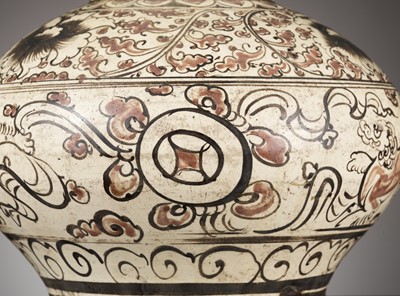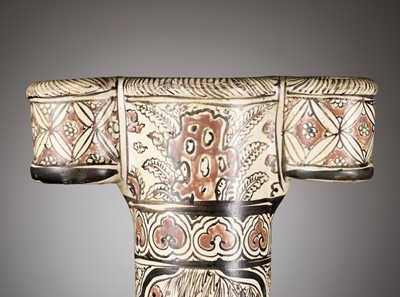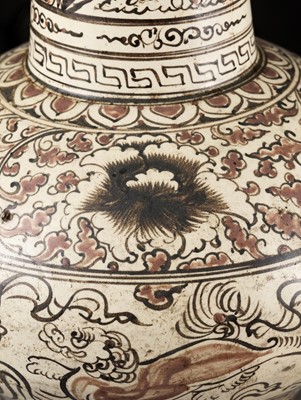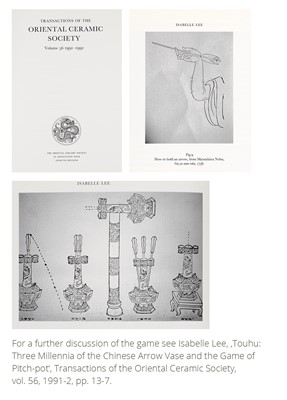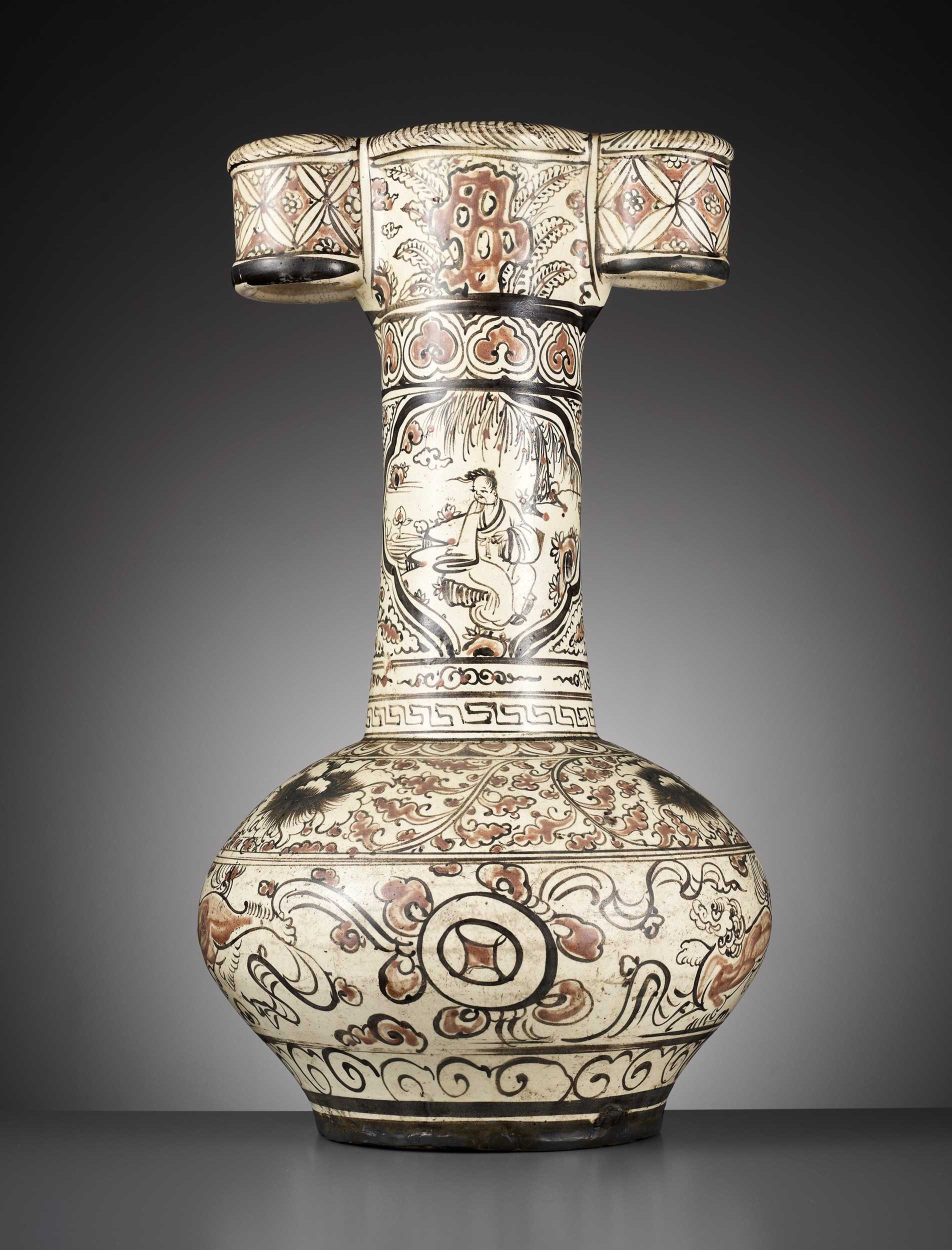29th Sep, 2022 13:00
DAY 1 - TWO-DAY AUCTION - Fine Chinese Art / 中國藝術集珍 / Buddhism & Hinduism
106
A VERY LARGE AND EXTREMELY RARE CIZHOU PAINTED ARROW VASE, TOUHU, MING DYNASTY
明代罕見磁州窯彩繪投壺
Sold for €26,000
including Buyer's Premium
Published: Michael B. Weisbrod, Inc., From Kilns of Kings and Commoners, 1990, New York, page 68, catalog number 27.
Opinion: Except for a similar yet smaller example in the British Museum, the present lot seems to be the only surviving example of a group of Cizhou Touhu vases, probably made for Imperial use during the mid-15th to mid-16th century. The curator of the British Museum, Rebecca Harrison-Hall, comments on the rare vessel as follows: “Two earlier arrow vases of this shape, made of bronze, were excavated from a tomb (M.13) in Pinghu county, Sichuan province. Archaeologists believe that the tomb belonged to the father of the scholar Wang Xi (1405-52) or to one of Wang Xi's father's wives. A number of bronze and iron arrow vases have been collected by Professor Jessica Rawson for the British Museum for future publication. The style of figure painting relates closely to that of blue-and-white wares of the Jiajing period, which were made at Jingdezhen.”
China, 15th-16th century. The compressed globular body supported on a low, thick foot and rising to a tall, slightly waisted neck, flanked at the top by two tubular arrow holes, the mouth and each of the arrow holes with thick lipped rims. The exterior densely decorated in brown and black painting above a cream-colored slip.
Provenance: Warren E. Cox (1895-1977), New York, USA. A private collection in New York, USA, acquired from the above after 1977. A private collector in Toronto, Canada, acquired from the above. Michael B. Weisbrod, Inc., New York, acquired from the above in 1990. An important North American collection, acquired from the above. Warren Earle Cox (1895-1977) was an important New York antiques dealer and an authority on porcelain and pottery from around the world. His two-volume work “The Book of Pottery and Porcelain” became a standard reference in the field.
Condition: Superb condition commensurate with size and age. Some old wear and firing flaws, including open bubbles, firing cracks, pitting, and dark spots, all as expected for Ming dynasty Cizhou wares. Minor glaze flaking along the rims and base with associated small touchups. Minuscule losses, nicks and shallow surface scratches.
Weight: 6,386 g
Dimensions: Height 43.6 cm
The neck masterfully painted with shaped reserves enclosing sages dressed in loose-fitting robes seated amid trees, clouds, and lotus, all below scholar’s rocks and plantain leaves as well as a band of ruyi-heads and above bands of key-fret and scroll. The body with a band of lotus petals at the shoulder, above a band of peony blossoms and scrolling vines, and a band of Buddhist lions striking different poses and divided by their ribboned brocade balls, with a scroll band above the foot. The arrow holes with floral diaper.
Arrow vases were made for a drinking game called 'touhu', which had been popular among elite men and women from the Spring and Autumn period (770-476 BC). Players threw arrows into bronze or ceramic vases with narrow tubular necks at prescribed intervals, each player equidistant from the vase. The winner successfully projected all his arrows into the vase and the loser was forced to drink at each miss. Elaborate rituals and intricate rules, recorded in the Li Ji (Book of Rites), added further complexity to the game. Puzzling pitching techniques were described in the Touhu Yijie (Ceremonial Usages and Rules of Touhu), an illustrated manual written by Wang Ti (1490-1530), and these shots were given fancy names, like ‘A Pair of Dragons Enters the Sea’ when two arrows were thrown from a great height at once into the vase. The touhu game was used to practice archery, one of the essential accomplishments of a gentleman. Later in the Ming era, the game became more widespread and was played by rich merchants as well as the aristocracy and scholarly elite. A scene in the famous late Ming novel Jin Ping Mei (Plum Blossom in the Golden Vase), written in 1619, describes the wealthy merchant Ximen Qing's seduction of his concubine Panjinlian. She becomes inebriated while playing touhu on a picnic and the game leads to an amorous encounter. For a further discussion of the game see Isabelle Lee, 'Touhu: Three Millennia of the Chinese Arrow Vase and the Game of Pitch-pot', Transactions of the Oriental Ceramic Society, vol. 56, 1991-2, pp. 13-7.
Literature comparison:
Compare a closely related Cizhou painted touhu, 40 cm high, dated to the Ming dynasty, circa 1522-1566, in the collection of the British Museum, museum number 1937,0716.74.
Auction result comparison:
Type: Related
Auction: Christie’s New York, 17 March 2017, lot 1174
Price: USD 68,750 or approx. EUR 77,500 converted and adjusted for inflation at the time of writing
Description: A painted Cizhou jar, Yuan dynasty
Expert remark: Compare the related manner of painting showing similar figures within shaped reserves. Note, however, that the present arrow vase is much rarer, of more elaborate form and decoration, and slightly larger than this jar (35 cm).
明代罕見磁州窯彩繪投壺
中國,十五至十六世紀。長直頸、兩側貫耳,圓鼓腹,足底露胎,刮痕粗顯,胎質堅硬,色呈淺灰。唇口、内壁和外壁罩白釉,色澤乳白微黃。外壁彩繪人物、神獸以及纏枝花卉等紋樣。
出版:Michael B. Weisbrod,Inc.,From Kilns of Kings and Commoners,1990年,紐約,頁68,畫冊第27號。
專家注釋:除了大英博物館的一個相似但較小的例子外,本拍品似乎是唯一倖存的一件磁州窯彩繪投壺,可能是十五世紀中葉至十六世紀中葉為皇家使用而製作的。 大英博物館館長Rebecca Harrison-Hall 評論這件稀有器物如下:“在四川省平湖縣的一個墓葬 (M.13) 中出土了兩個早期的這種形狀的青銅投壺······Jessica Rawson教授為大英博物館收藏了許多青銅和鐵製投壺,以備將來出版。人物畫的風格與景德鎮出產的嘉靖青花瓷器風格極爲相似。”
來源:紐約Warren E. Cox (1895-1977)收藏;一個紐約私人收藏1977年之後購於上述收藏;加拿大多倫多私人收藏購於上述收藏;紐約Michael B. Weisbrod藝廊1990年購於上述收藏;一個北美私人收藏購於上述收藏;Warren Earle Cox (1895-1977) 曾是紐約一個重要古玩商人,也是陶瓷界的權威。他的兩本《The Book of Pottery and Porcelain》成為陶瓷界的標準參考書。
品相:品相極好,與其大小和年代相稱。一些磨損和燒製缺陷,包括開泡、燒裂、麻點和黑點,這些都與明代磁州瓷器的預期相符。邊沿和底部少量釉料剝落以及相應的小修飾。微小的缺損、刻痕和表面淺劃痕。
重量:6,386 克
尺寸:高 43.6 厘米
頸部分層彩繪,分別爲假山竹林層、如意紋層、開光人物場景層、卷草紋層以及曲紋層。其中開光人物分別爲文官與書生坐在山水景觀中,衣袍飄揚,十分瀟灑。肩部牡丹卷葉紋,腹部太獅身姿各異,與錦毬嬉戲。兩貫耳飾四瓣花卉紋。
投壺最早應是東周與春秋左近出現,源流本為“射禮”。最早投壺不是遊戲,而是諸侯國間的國家禮儀。投壺成為遊戲,是戰國後期才開始的。此等遊戲,在皇家燕宴,士大夫、文人們宴飲或雅集之際,必得以“雅歌”伴“投壺”助興。其投壺技巧百出,有背向反投者,遮目盲投者,隔了屏風越投者,或各種舞蹈技藝投壺者等等,不一而足。《禮記》中記錄的精心制定的儀式和復雜的規則。明代投壺,又有新的發展,投擲技法百有四十,這在《投壺奏矢》一書中有載。1619年著名的《金瓶梅》書中,就描寫了西門慶勾引潘金蓮的場景,其中就有投壺的游戲。有關投壺遊戲的進一步討論,請參見 Isabelle Lee,《Touhu:Three Millennia of the Chinese Arrow Vase and the Game of Pitch-pot',Transactions of the Oriental Ceramic Society》,卷56,1991年第2冊,頁13-7。
文獻比較:
比較一件非常相近的明代約1522-1566年磁州窯彩繪投壺,40 厘米高,收藏於大英博物館,編號1937,0716.74。
拍賣結果比較:
形制:相近
拍賣:紐約佳士得,2017年3月17日,lot 1174
價格:USD 68,750(相當於今日EUR 77,500)
描述:元代磁州窯彩繪罐
專家評論:比較相近的繪畫的方式,例如開光人物場景。然而請注意,現拍品投壺更為罕見,其形式和裝飾更為精緻,而且比此罐略大 (35 厘米)。
#videohighlight
Published: Michael B. Weisbrod, Inc., From Kilns of Kings and Commoners, 1990, New York, page 68, catalog number 27.
Opinion: Except for a similar yet smaller example in the British Museum, the present lot seems to be the only surviving example of a group of Cizhou Touhu vases, probably made for Imperial use during the mid-15th to mid-16th century. The curator of the British Museum, Rebecca Harrison-Hall, comments on the rare vessel as follows: “Two earlier arrow vases of this shape, made of bronze, were excavated from a tomb (M.13) in Pinghu county, Sichuan province. Archaeologists believe that the tomb belonged to the father of the scholar Wang Xi (1405-52) or to one of Wang Xi's father's wives. A number of bronze and iron arrow vases have been collected by Professor Jessica Rawson for the British Museum for future publication. The style of figure painting relates closely to that of blue-and-white wares of the Jiajing period, which were made at Jingdezhen.”
China, 15th-16th century. The compressed globular body supported on a low, thick foot and rising to a tall, slightly waisted neck, flanked at the top by two tubular arrow holes, the mouth and each of the arrow holes with thick lipped rims. The exterior densely decorated in brown and black painting above a cream-colored slip.
Provenance: Warren E. Cox (1895-1977), New York, USA. A private collection in New York, USA, acquired from the above after 1977. A private collector in Toronto, Canada, acquired from the above. Michael B. Weisbrod, Inc., New York, acquired from the above in 1990. An important North American collection, acquired from the above. Warren Earle Cox (1895-1977) was an important New York antiques dealer and an authority on porcelain and pottery from around the world. His two-volume work “The Book of Pottery and Porcelain” became a standard reference in the field.
Condition: Superb condition commensurate with size and age. Some old wear and firing flaws, including open bubbles, firing cracks, pitting, and dark spots, all as expected for Ming dynasty Cizhou wares. Minor glaze flaking along the rims and base with associated small touchups. Minuscule losses, nicks and shallow surface scratches.
Weight: 6,386 g
Dimensions: Height 43.6 cm
The neck masterfully painted with shaped reserves enclosing sages dressed in loose-fitting robes seated amid trees, clouds, and lotus, all below scholar’s rocks and plantain leaves as well as a band of ruyi-heads and above bands of key-fret and scroll. The body with a band of lotus petals at the shoulder, above a band of peony blossoms and scrolling vines, and a band of Buddhist lions striking different poses and divided by their ribboned brocade balls, with a scroll band above the foot. The arrow holes with floral diaper.
Arrow vases were made for a drinking game called 'touhu', which had been popular among elite men and women from the Spring and Autumn period (770-476 BC). Players threw arrows into bronze or ceramic vases with narrow tubular necks at prescribed intervals, each player equidistant from the vase. The winner successfully projected all his arrows into the vase and the loser was forced to drink at each miss. Elaborate rituals and intricate rules, recorded in the Li Ji (Book of Rites), added further complexity to the game. Puzzling pitching techniques were described in the Touhu Yijie (Ceremonial Usages and Rules of Touhu), an illustrated manual written by Wang Ti (1490-1530), and these shots were given fancy names, like ‘A Pair of Dragons Enters the Sea’ when two arrows were thrown from a great height at once into the vase. The touhu game was used to practice archery, one of the essential accomplishments of a gentleman. Later in the Ming era, the game became more widespread and was played by rich merchants as well as the aristocracy and scholarly elite. A scene in the famous late Ming novel Jin Ping Mei (Plum Blossom in the Golden Vase), written in 1619, describes the wealthy merchant Ximen Qing's seduction of his concubine Panjinlian. She becomes inebriated while playing touhu on a picnic and the game leads to an amorous encounter. For a further discussion of the game see Isabelle Lee, 'Touhu: Three Millennia of the Chinese Arrow Vase and the Game of Pitch-pot', Transactions of the Oriental Ceramic Society, vol. 56, 1991-2, pp. 13-7.
Literature comparison:
Compare a closely related Cizhou painted touhu, 40 cm high, dated to the Ming dynasty, circa 1522-1566, in the collection of the British Museum, museum number 1937,0716.74.
Auction result comparison:
Type: Related
Auction: Christie’s New York, 17 March 2017, lot 1174
Price: USD 68,750 or approx. EUR 77,500 converted and adjusted for inflation at the time of writing
Description: A painted Cizhou jar, Yuan dynasty
Expert remark: Compare the related manner of painting showing similar figures within shaped reserves. Note, however, that the present arrow vase is much rarer, of more elaborate form and decoration, and slightly larger than this jar (35 cm).
明代罕見磁州窯彩繪投壺
中國,十五至十六世紀。長直頸、兩側貫耳,圓鼓腹,足底露胎,刮痕粗顯,胎質堅硬,色呈淺灰。唇口、内壁和外壁罩白釉,色澤乳白微黃。外壁彩繪人物、神獸以及纏枝花卉等紋樣。
出版:Michael B. Weisbrod,Inc.,From Kilns of Kings and Commoners,1990年,紐約,頁68,畫冊第27號。
專家注釋:除了大英博物館的一個相似但較小的例子外,本拍品似乎是唯一倖存的一件磁州窯彩繪投壺,可能是十五世紀中葉至十六世紀中葉為皇家使用而製作的。 大英博物館館長Rebecca Harrison-Hall 評論這件稀有器物如下:“在四川省平湖縣的一個墓葬 (M.13) 中出土了兩個早期的這種形狀的青銅投壺······Jessica Rawson教授為大英博物館收藏了許多青銅和鐵製投壺,以備將來出版。人物畫的風格與景德鎮出產的嘉靖青花瓷器風格極爲相似。”
來源:紐約Warren E. Cox (1895-1977)收藏;一個紐約私人收藏1977年之後購於上述收藏;加拿大多倫多私人收藏購於上述收藏;紐約Michael B. Weisbrod藝廊1990年購於上述收藏;一個北美私人收藏購於上述收藏;Warren Earle Cox (1895-1977) 曾是紐約一個重要古玩商人,也是陶瓷界的權威。他的兩本《The Book of Pottery and Porcelain》成為陶瓷界的標準參考書。
品相:品相極好,與其大小和年代相稱。一些磨損和燒製缺陷,包括開泡、燒裂、麻點和黑點,這些都與明代磁州瓷器的預期相符。邊沿和底部少量釉料剝落以及相應的小修飾。微小的缺損、刻痕和表面淺劃痕。
重量:6,386 克
尺寸:高 43.6 厘米
頸部分層彩繪,分別爲假山竹林層、如意紋層、開光人物場景層、卷草紋層以及曲紋層。其中開光人物分別爲文官與書生坐在山水景觀中,衣袍飄揚,十分瀟灑。肩部牡丹卷葉紋,腹部太獅身姿各異,與錦毬嬉戲。兩貫耳飾四瓣花卉紋。
投壺最早應是東周與春秋左近出現,源流本為“射禮”。最早投壺不是遊戲,而是諸侯國間的國家禮儀。投壺成為遊戲,是戰國後期才開始的。此等遊戲,在皇家燕宴,士大夫、文人們宴飲或雅集之際,必得以“雅歌”伴“投壺”助興。其投壺技巧百出,有背向反投者,遮目盲投者,隔了屏風越投者,或各種舞蹈技藝投壺者等等,不一而足。《禮記》中記錄的精心制定的儀式和復雜的規則。明代投壺,又有新的發展,投擲技法百有四十,這在《投壺奏矢》一書中有載。1619年著名的《金瓶梅》書中,就描寫了西門慶勾引潘金蓮的場景,其中就有投壺的游戲。有關投壺遊戲的進一步討論,請參見 Isabelle Lee,《Touhu:Three Millennia of the Chinese Arrow Vase and the Game of Pitch-pot',Transactions of the Oriental Ceramic Society》,卷56,1991年第2冊,頁13-7。
文獻比較:
比較一件非常相近的明代約1522-1566年磁州窯彩繪投壺,40 厘米高,收藏於大英博物館,編號1937,0716.74。
拍賣結果比較:
形制:相近
拍賣:紐約佳士得,2017年3月17日,lot 1174
價格:USD 68,750(相當於今日EUR 77,500)
描述:元代磁州窯彩繪罐
專家評論:比較相近的繪畫的方式,例如開光人物場景。然而請注意,現拍品投壺更為罕見,其形式和裝飾更為精緻,而且比此罐略大 (35 厘米)。
#videohighlight
Zacke Live Online Bidding
Our online bidding platform makes it easier than ever to bid in our auctions! When you bid through our website, you can take advantage of our premium buyer's terms without incurring any additional online bidding surcharges.
To bid live online, you'll need to create an online account. Once your account is created and your identity is verified, you can register to bid in an auction up to 12 hours before the auction begins.
Intended Spend and Bid Limits
When you register to bid in an online auction, you will need to share your intended maximum spending budget for the auction. We will then review your intended spend and set a bid limit for you. Once you have pre-registered for a live online auction, you can see your intended spend and bid limit by going to 'Account Settings' and clicking on 'Live Bidding Registrations'.
Your bid limit will be the maximum amount you can bid during the auction. Your bid limit is for the hammer price and is not affected by the buyer’s premium and VAT. For example, if you have a bid limit of €1,000 and place two winning bids for €300 and €200, then you will only be able to bid €500 for the rest of the auction. If you try to place a bid that is higher than €500, you will not be able to do so.
Online Absentee and Telephone Bids
You can now leave absentee and telephone bids on our website!
Absentee Bidding
Once you've created an account and your identity is verified, you can leave your absentee bid directly on the lot page. We will contact you when your bids have been confirmed.
Telephone Bidding
Once you've created an account and your identity is verified, you can leave telephone bids online. We will contact you when your bids have been confirmed.
Classic Absentee and Telephone Bidding Form
You can still submit absentee and telephone bids by email or fax if you prefer. Simply fill out the Absentee Bidding/Telephone bidding form and return it to us by email at office@zacke.at or by fax at +43 (1) 532 04 52 20. You can download the PDF from our Upcoming Auctions page.
How-To Guides
How to Create Your Personal Zacke Account
How to Register to Bid on Zacke Live
How to Leave Absentee Bids Online
How to Leave Telephone Bids Online
中文版本的操作指南
创建新账号
注册Zacke Live在线直播竞拍(免平台费)
缺席投标和电话投标
Third-Party Bidding
We partner with best-in-class third-party partners to make it easy for you to bid online in the channel of your choice. Please note that if you bid with one of our third-party online partners, then there will be a live bidding surcharge on top of your final purchase price. You can find all of our fees here. Here's a full list of our third-party partners:
- 51 Bid Live
- EpaiLive
- ArtFoxLive
- Invaluable
- LiveAuctioneers
- the-saleroom
- lot-tissimo
- Drouot
Please note that we place different auctions on different platforms. For example, in general, we only place Chinese art auctions on 51 Bid Live.
Bidding in Person
You must register to bid in person and will be assigned a paddle at the auction. Please contact us at office@zacke.at or +43 (1) 532 04 52 for the latest local health and safety guidelines.
